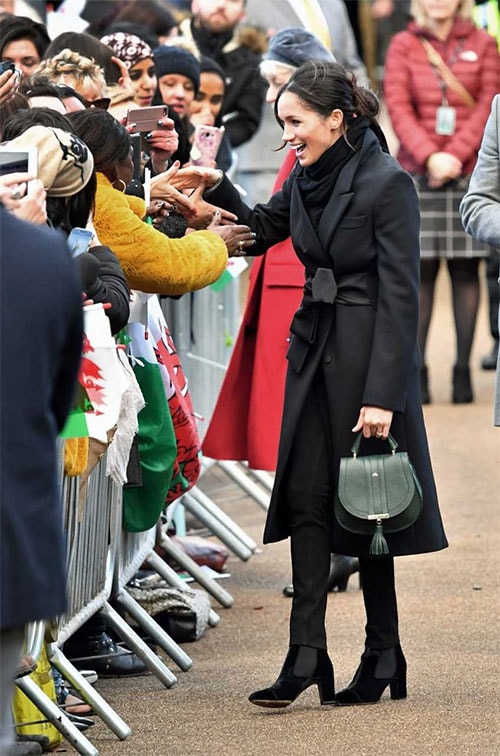
Meghan Markle's preference for eco-conscious and sustainable fashion and beauty products is a matter of record in style circles. As a popular and widely-loved actress and the brain behind the now shuttered lifestyle website, The Tig, she was a vocal advocate of responsible fashion. As a soon-to-be royal with a massive following that is eager to emulate her style, she wields even more influence. And fortunately, she's using her celebrity to make a point about philanthropy through fashion even more decidedly, without saying a word.
A few days ago, during a trip to Cardiff with fiancé Prince Harry, Meghan's fashion choices spoke volumes about the causes she has and will continue championing. Sporting an elegant all-black ensemble, she paired it with a forest green handbag to add a little colour to the look. While stylish, there's nothing remarkable about that look on its own. But the designers Meghan chose are telling. Her black coat was by Stella McCartney, who is known for being a champion of cruelty-free and sustainable clothing. The handbag was from DeMellier London (previously called Milli Millu), which donates a portion of its proceeds from the sale of each bag to help prevent children's mortality. The coup de grace, though, was Meghan opting to wear a pair of black denims from Hiut Denim, a little-known Welsh brand that produces only 100 pairs of denims a week and provides free repairs to its clothes for life. In one fell swoop, not only did Meghan make a powerful point about eco-conscious fashion, but also managed to give a quiet hat-tip to local designers of the place she was visiting.

Meghan Markle on a visit to Cardiff, Wales (Image Credit: AFP)
Now that's what we call royal style.
If you're as inspired by Meghan to make small changes to make your fashion more sustainable and eco-friendly, here are three simple tips to get you started.
Fabrics matter
Synthetic fabrics might be cheaper, but the eco-system pays a steep price for their use. Synthetic fabrics such as polyester and nylon are made using fossil fuels. In addition to being non-biodegradable, the process of making them releases large amounts of carbon dioxide in the air - more than three times than that while producing cotton. Now consider this: this highly harmful polyester makes up for 60% of our garments. No wonder that the fashion industry is considered the second-largest polluter in the world, right behind oil. So the point is, pause to think about the fabric you're wearing. Natural fabrics are much more eco-friendly than man-made ones. Among natural fabrics, while organic cotton is the most popular, it takes a lot of water to produce, so try buying silk, wool, hemp or linen instead.
Support local designers
Fast fashion companies might help us hoard a lot more because of their very low price points, but in addition to using synthetic fabrics and cheap, inexpensive chemical dyes, they are produced in countries with cheap labour prices. The process of importing and distributing them across continents can leave a massive carbon footprint. Buying organic natural fabrics will make little difference if the fabric has been sourced from one country, stitched in a second and dyed in a third. Instead, opt for local designers with production and distribution facilities in the vicinity.
Buy and discard thoughtfully
When you're not quick to buy and quicker to discard, inevitably, there will be fewer clothes ending up in landfills, clogging up our fragile eco-system. To understand the magnitude of the problem, here's a factoid - every year, the fashion industry produces roughly 80 billion articles of clothing and three out of four of these end up in landfills or are burnt. Every bit counts, so before you buy or discard, try upcycling and recycling among family and friends.
So, be like Meghan Markle.
Track Latest News Live on NDTV.com and get news updates from India and around the world
